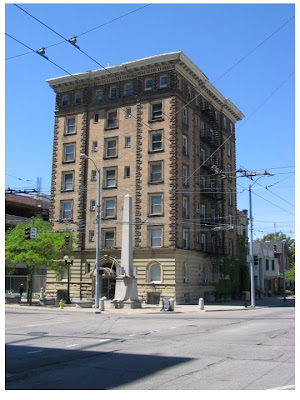Historically, though, downtown had a mix of single family homes, apartments or living rooms above stores (walk-ups), and, later in the 19th century, residential hotels and apartment houses. These were found usually on the edges of downtown, but also fairly close in, like the Arcade apartments, and these two buildings at the northeast corner of 3rd & Ludlow, on the current site of the DP&L building.
 The building on the corner was the Atlas Hotel, and to the right was the Ratterman Apartments (with a retal arcade on the ground floor). The eastern facade of the Ratterman faced the old courthouse and jail, as well as a little lane, so, though a deep building, there was some natural light to the rooms.
The building on the corner was the Atlas Hotel, and to the right was the Ratterman Apartments (with a retal arcade on the ground floor). The eastern facade of the Ratterman faced the old courthouse and jail, as well as a little lane, so, though a deep building, there was some natural light to the rooms.And you have to like the facade articulation of both buildings, with the bay windows.
Another example is this building, from 1901, at the northeast corner of 5th and Wilkinson, more on the edge of downtown. A good example of adapting the Italian Renaissance palazzo form for an "elevator building", rusticated base, extruded piano nobile into a shaft, then topping off with a cornice and some top detailing. And more great bay windows.
 Yet another example is this elevator building, at the SW corner of Monument and Main, built sometime in the later 1890s (on the site of the relocated Newcom Tavern, the oldest structure in the city). The 1890s date marks this as one of the older high-rises in the Dayton.
Yet another example is this elevator building, at the SW corner of Monument and Main, built sometime in the later 1890s (on the site of the relocated Newcom Tavern, the oldest structure in the city). The 1890s date marks this as one of the older high-rises in the Dayton. Based on the verticle sign it was called the Harbor Hotel or Harbor Apartments at one time. And note the next door neighborhoods in this 1920s pix; a surviving single family home.
Based on the verticle sign it was called the Harbor Hotel or Harbor Apartments at one time. And note the next door neighborhoods in this 1920s pix; a surviving single family home.And it survives to this day, now named Newcom Manor. Interestingly, this is not the last of it's type as the Eva Feldman Apartments, from the 1960's, is typologically similar, though done up as modern architecture.
Newcom Manor, a builiding on west 3rd, and the Arcade are the last survivors of the prewar residential elevator buildings, though (and Newcom Manor is the oldest).
 The exterior detailing is quite good. One can detect Sullivanesque touches in the arch decoration. Based on the detailing elsewhere on the facade (like the elaborate rustication, the stylized quoins, and exaggerated cornice) perhaps Mannerist palazzos, rather than early or high Renaissance, was the model (that massive cornice does bring to mind the Palazzo Faranese)
The exterior detailing is quite good. One can detect Sullivanesque touches in the arch decoration. Based on the detailing elsewhere on the facade (like the elaborate rustication, the stylized quoins, and exaggerated cornice) perhaps Mannerist palazzos, rather than early or high Renaissance, was the model (that massive cornice does bring to mind the Palazzo Faranese)
Yet this ground level detailing creates a rich and textured wall surface, adding visual interest at pedestrian scale, yet still transitioning the facade down to a solid-appearing base at street level.
The building has these half-basement spaces, with their own entrances. Based on the city directories these were retail spaces of various types, like coin dealers and cleaners and tailors. Nice little detail with that decorative wrought iron over the door, too.
 The half-basement concept also raises the firs floor windows to just at or above eye-level, providing visual privacy for the interior.
The half-basement concept also raises the firs floor windows to just at or above eye-level, providing visual privacy for the interior.Newcom Manor from the corner, with the fire escape on the side fcade. One can see the context -sensitive facade composition with the articulation of the fours corners via various moves, which activates the facade, remains true to symmetric compostion, but perhaps also references the corner site of the building.
 To the side one can see some remnant housing along Monument Street, which brings to mind that, when built, this structure was in a residential area, and downtown expanded around it. Perhaps the scale of this building vis a vis its surroundings marks this as an early move in downtowns expansion north and west.
To the side one can see some remnant housing along Monument Street, which brings to mind that, when built, this structure was in a residential area, and downtown expanded around it. Perhaps the scale of this building vis a vis its surroundings marks this as an early move in downtowns expansion north and west.The obelisk is part of the urban design scheme from the early 1990s, which developed this block as a gateway feature to downtown, with the Monument as the centerpiece. This is one of the best urban design moves in Dayton, but not really recognized as such.
We'll take a look at the Monument ensemble next.
No comments:
Post a Comment